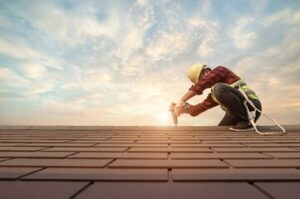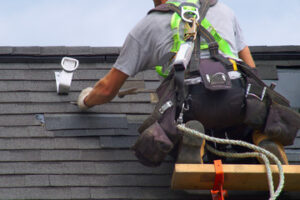It’s not fun to think about roof repair—especially when it involves howling gale force winds, torrential rain or an incoming blizzard. But, ignoring the problem will only lead to expensive damage and potential water leaks inside your home.

Conduct regular inspections after severe storms or other events to catch problems early and take preventative measures. Visit https://www.bostonroofingco.com/ to learn more.
Shingles are the outermost layer of a roof and play an important role in protecting the home from weather elements. They protect the underlying roof structure from water and UV rays, and they help to insulate the home, keeping it warm in the winter and cool in the summer. When shingles are properly installed and maintained, they can provide years of protection for the house. However, if shingle damage goes unchecked, it can lead to leaks and other costly problems. That’s why it’s so important to perform regular inspections of a shingle roof and to address any minor issues as they arise.
Some of the most common signs that a shingle roof needs repair or replacement are curling, clawing, and missing shingles. The former two problems can expose the roof to moisture, which can cause structural damage and mold and mildew growth inside the house. The latter problem can leave the roof susceptible to being ripped away by strong winds.
Other shingle roof problems include cracked shingles and sagging or uneven areas. Cracked shingles create openings where water, debris, and insects can enter the house. In addition, sagging areas may be due to trapped moisture that can rot the underlying boards and support structures. If you see any of these signs, schedule a shingle roof repair immediately.
Besides the aesthetic benefits of having a beautiful roof, quality shingle repairs are also beneficial to the resale value of a home. A well-maintained and attractive roof demonstrates that the home is cared for, which can attract buyers and increase its resale value.
Aside from the aforementioned advantages of a well-maintained shingle roof, proper maintenance can extend its lifespan by up to 40-70 years in less humid climates. This makes shingle roof repair an affordable investment for any homeowner.
Flashing
Flashing is a critical component that seals the gaps between roof structures and walls. It’s particularly important around roof intersections and projections, such as chimneys, dormers, vent pipes, window openings and other features. Flashing helps prevent rainwater from seeping into walls or finding places underneath shingles where it can cause hidden mold and rot. Flashing can be made from many types of material, including modern composite substances and metals such as copper and aluminum. Metal flashing tends to last longer than plastic or composite products.
Like a tributary is to a river, the flashing on a roof guides water into gutters and off the roof. It also protects the walls at roof corners and penetration points. When the flashing becomes damaged, it’s vital to promptly repair it to avoid costly water damage.
While some do-it-yourselfers may attempt to replace flashing, it’s best to leave this to a professional. This job is complex and requires extensive knowledge of roofing to ensure a watertight fit. If a homeowner suspects flashing is damaged or worn, they should contact their roofing contractor immediately.
One of the most common causes of roof leaks is compromised flashing. During a thorough roof inspection, homeowners should look for signs of moisture intrusion. If there are water stains on ceilings or inside rooms, this often indicates that the flashing is leaking. Similarly, water stains directly below a roof structure such as a chimney or vent can be an indicator of faulty flashing.
Roof flashing is typically a two-part system that includes base and counter flashings. The base flashing, which is installed at the point where the roofing surface meets a vertical structure such as a wall, guards against water intrusion into the roof deck. The counter flashing, which is placed opposite to and above the base flashing, covers and protects it.
Another important type of flashing is valley flashing, which is installed in the middle section of a roof where two slopes meet. These areas are prone to leakage because of the large volume of water that collects there during even light rainfall. Valley flashing is typically constructed of long pieces of metal shaped to fit into the valley, and the edges of both slopes are overlapped to create a watertight seal.
Built-up roofing (BUR)
Built-up roofing is an old, established system that involves layering, or “building up,” multiple layers of material to create a solid roof covering. BUR is most often found on low-slope or flat commercial buildings, and it’s one of the most durable options available for commercial roofs. BUR is commonly made of alternating layers of bitumen (typically asphalt) and reinforcing fabrics.
The many layers of a BUR roof make it particularly resilient to weather conditions and physical damage, and it’s highly water resistant. This makes it a good choice for regions that experience extreme temperatures and heavy rainfall.
It’s also fire-resistant, which is an important factor for safety in commercial building environments. Additionally, BUR is often paired with reflective coatings to improve energy efficiency.
Because of its durability and longevity, a BUR roof may last for 30 years or more with regular maintenance. However, it’s important to remember that this type of commercial roof requires specialized care from experienced and skilled service technicians.
A professional should inspect a BUR roof after strong storms to check for any damage or areas of concern. These areas could include cracks or deterioration, which can lead to the formation of leaks. A commercial roofing expert can recommend the best course of action to repair any problems.
Typically, a BUR roof is installed in several phases, starting with a base sheet that’s either nailed or fully adhered to the roof deck. Then, a series of alternating ply sheets are applied on top of the base sheet. The final ply is topped with either gravel or a reflective cap sheet.
A gravel BUR offers a more rustic and rugged look, while a smooth tar BUR has a sleeker surface appearance. The surfacing on both types is intended to protect the roof membrane, but it’s important that you understand your specific roofing needs and choose the right option for your building.
Gutters
Gutters are troughs attached to the edges of a roof that collect and discharge rainwater, as well as divert it away from the foundation of a house or building. They also protect the fascia and soffit, which are exposed wood along the edge of a roof overhang, from water damage and rot. Gutters also help to prevent soil erosion, which can affect the integrity of a foundation and basement over time.
Gutter systems are an important part of a roof and should be cleaned regularly to maintain their function. Clogged gutters leave water with nowhere to go, which can lead to a flooded roof, rotten siding and a wet crawl space or basement. It can also cause foundation problems, as water can pressure against the walls of a home or business.
Regular cleaning of a roof and its gutters is an integral part of a comprehensive maintenance program. It should be done at least twice a year to remove debris, such as leaves, branches and twigs that accumulate over the course of a season. This process should also include a check for signs of damage to the gutters and roof, such as cracks, holes or loose connections.
It is also important to note that gutters can be a breeding ground for rodents and other pests. Therefore, it is essential to install gutter guards, which are mesh screens that cover the top of a gutter system to deter animals and insects from accessing the roof.
It is also recommended to hire a professional for gutter cleaning, as it can be dangerous to climb ladders and remove debris from the top of a high structure. It is best to start at one end of the gutter and work your way around, taking care to avoid putting yourself at risk of falling or becoming injured. For safety, it is also a good idea to use handheld tools that can reach small spaces and a bucket to store twigs and other debris that cannot fit in your bag. You should also be sure to wear gloves when handling twigs and other items, as they can be covered in mold and other harmful bacteria.

